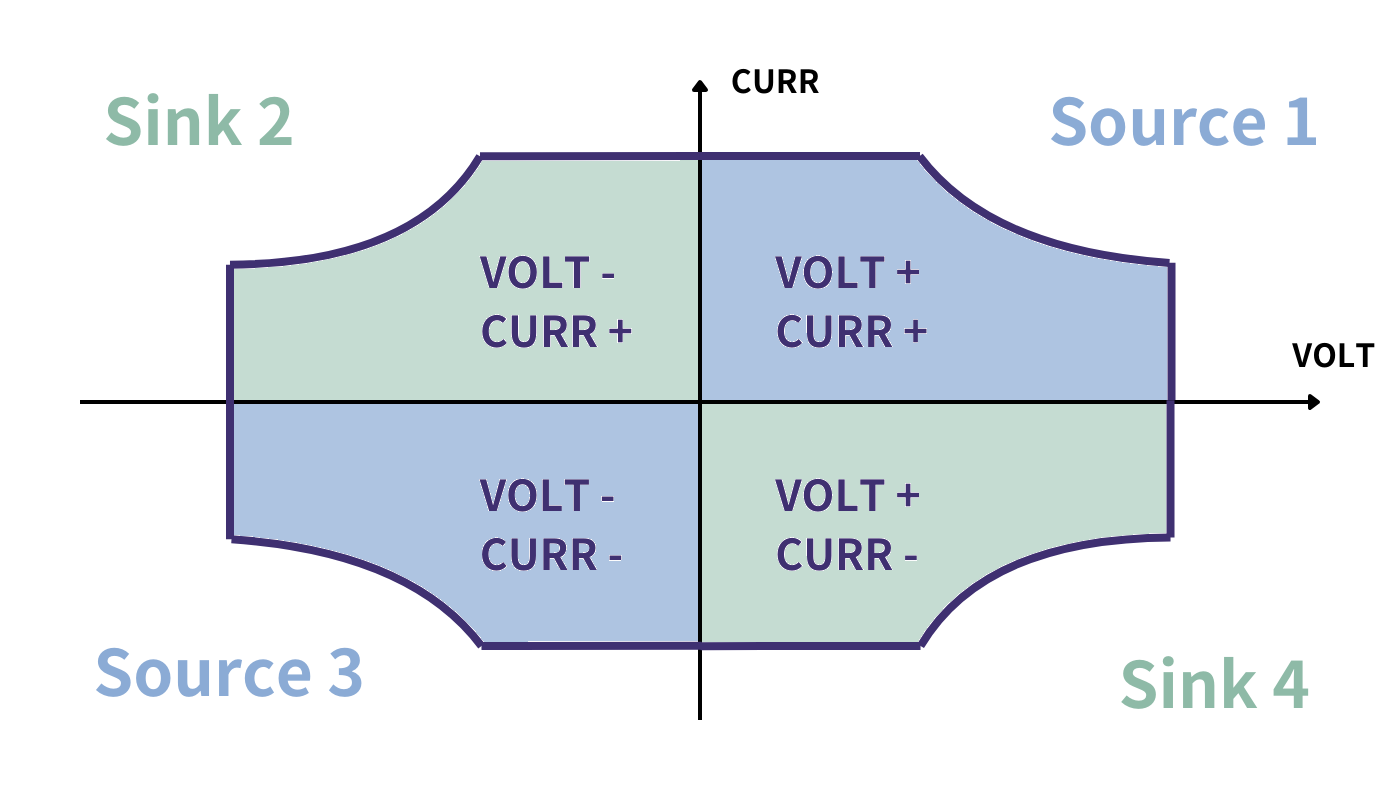1. Introduction: The Critical Role of Constant Current in Modern Grid Testing
In today’s power‐dependent world—especially as electric vehicles (EVs), renewable energy systems, and advanced energy storage proliferate—the stability and adaptability of our electrical grids have become paramount. Even minor voltage or current fluctuations can severely impact sensitive equipment. Traditional grid simulators, which often provide unidirectional power flow, are increasingly inadequate for the dynamic challenges of modern power systems.
Enter Four‑Quadrant Grid Simulation: a cutting‑edge solution that not only emulates complex voltage and current scenarios but also offers bidirectional control and energy feedback. This technology ensures that testing equipment can operate continuously under both power delivery and energy recovery conditions. Constant current technology plays an indispensable role in this approach, automatically adjusting to maintain stable current flow regardless of fluctuating grid conditions.
Systems such as the RPS‑5000G are designed to meet these demanding requirements by leveraging next‑generation silicon carbide (SiC) MOS technology and intelligent constant power output. These systems provide the reliable constant current support necessary for rigorous grid testing and validation across high‑load, high‑voltage, and energy recovery scenarios.
For more details on our advanced testing solutions, visit our Home page.
2. Fundamental Principles of Four‑Quadrant Grid Simulation

2.1 Definition and Importance
Four‑Quadrant Grid Simulation refers to the capability of a grid simulator to control both current and voltage in all four operational quadrants. Each quadrant represents a distinct combination of current and voltage polarity:
- First Quadrant: Positive current and positive voltage – the standard mode of power supply.
- Second Quadrant: Negative current with positive voltage – simulating power feedback to the grid.
- Third Quadrant: Negative current and negative voltage – representing energy absorption during reverse power flow.
- Fourth Quadrant: Positive current with negative voltage – simulating conditions such as energy regeneration.
This comprehensive approach allows for emulation of real‑world grid conditions, making it especially valuable in EV charger testing, renewable energy applications, and server power system evaluations. For instance, in EV charging tests, simulators can mimic both power draw (during charging) and power feedback (during vehicle-to-grid operations), thus providing a realistic environment for verifying equipment performance.
2.2 Power Feedback and Energy Recovery
A standout feature of four‑quadrant simulators is their inherent ability to deliver power feedback and recover energy. Unlike traditional unidirectional simulators, these systems can:
- Return excess energy to the grid during periods of low demand.
- Minimize energy wastage, thus reducing overall power consumption.
- Enhance sustainability by aligning with green energy practices and lowering operating costs.
This energy recovery function is particularly beneficial during prolonged testing of high‑power equipment, such as server power supplies and data center systems, where it helps to significantly reduce energy consumption and costs.
3. Core Technologies and Equipment Requirements
3.1 Technical Specifications and Functionalities
High‑performance four‑quadrant grid simulators must deliver rapid response times and real‑time adjustments. Key technical features include:
- High‑Accuracy Power Amplifiers: Essential for maintaining stable output despite rapid voltage or current fluctuations.
- Fast Current Controllers: Capable of response times as low as 1 millisecond to emulate transient grid conditions accurately.
- Bidirectional Operation: Ability to both supply power and feed energy back into the grid, which is crucial for simulating energy feedback scenarios.
For instance, modern simulators can adapt to sudden changes in grid conditions, making them ideal for testing applications in EV charging and renewable energy sectors.
3.2 Compliance with Key Testing Standards
Four‑Quadrant Grid Simulators must comply with various industry standards to ensure reliability and safety. Commonly referenced standards include:
| Standard | Purpose | Details |
|---|---|---|
| IEEE 1547 | Grid‑connected power systems, especially distributed generation | Ensures stable operation of distributed energy systems under grid conditions |
| UL 1741 | Inverter testing standards | Confirms that inverters can respond swiftly to grid fluctuations |
| IEC 61000‑3 | Electromagnetic compatibility (EMC) for harmonic emissions | Ensures minimal harmonic distortion within electrical networks |
| IEC 61000‑4 | EMC immunity requirements | Verifies device reliability in varying electromagnetic environments |
Adherence to these standards guarantees that four‑quadrant grid simulators offer a safe, reliable, and realistic testing environment, crucial for applications across multiple sectors.
For additional technical details, please see our Renewable Energy Testing Solutions page.
4. Application Scenarios for Four‑Quadrant Grid Simulation
The flexibility and precision of four‑quadrant grid simulation make it ideal for a wide range of testing scenarios:
| Application | Description | Examples |
|---|---|---|
| EV Charging Station Testing | Evaluates performance under varying load conditions, including bidirectional power flow during charging and discharging cycles. | Testing full‑load, partial‑load, and low‑load conditions for EV chargers. |
| Renewable Energy Testing | Ensures the stability of renewable energy devices under fluctuating conditions due to variable sunlight or wind speeds. | Solar inverter testing under changing light intensities; wind turbine testing. |
| Data Storage & Server Power Testing | Simulates voltage and current transients to test power supply stability in sensitive environments such as data centers. | Evaluating server power supplies during voltage surges or transient events. |
| Aerospace Equipment Testing | Verifies power reliability in avionics and satellite systems under extreme conditions. | Testing satellite power systems under rapid load changes. |
| Industrial Automation Systems | Assesses the operational stability of automated industrial systems during power disturbances. | Testing robotic systems and factory automation equipment. |
| Consumer Electronics Testing | Validates the performance of household electronics subjected to grid fluctuations and transient loads. | Testing voltage stability for smart home devices during power outages. |
Each application benefits from the simulator’s ability to deliver constant current and handle complex bidirectional power scenarios, ensuring comprehensive and realistic testing.
For more details on our applications and innovative solutions, visit our Home page.
5. Advantages of Four‑Quadrant Grid Simulation
5.1 Precision, Efficiency, and Flexibility
Four‑quadrant simulators are unmatched in their ability to deliver real‑time, stable output through bidirectional control. Their precision ensures that testing is both accurate and repeatable, even under rapidly changing grid conditions. This flexibility allows them to be used in a variety of settings—from EV charging tests to industrial automation evaluations.
5.2 Energy Efficiency and Sustainability
The energy recovery capabilities of these simulators not only reduce power consumption during testing but also promote sustainable practices. By feeding excess energy back into the grid, they contribute to lowering overall energy usage and help organizations meet stringent emission and sustainability targets.
5.3 Operational Advantages
- Enhanced Testing Continuity:
Four‑quadrant simulators eliminate the interruptions common with traditional systems that require manual gear switching. - Cost‑Effective Operation:
By recovering energy and reducing waste, these systems lower testing costs. - Broad Spectrum Testing:
Their ability to handle both high‑power and low‑voltage scenarios makes them versatile tools for various applications.
For further insights into our product innovations, please explore our Model G Regenerative Grid Simulator.
6. Future Trends in Four‑Quadrant Grid Simulation
6.1 Technological Advancements
The rapid development of artificial intelligence (AI) and machine learning is set to revolutionize four‑quadrant grid simulation. Future systems may incorporate:
- Intelligent Real‑Time Adjustments:
AI algorithms could enable dynamic parameter tuning to optimize system performance. - Automated Fault Detection:
Integrated diagnostics may allow for predictive maintenance and real‑time fault detection, further enhancing testing reliability. - Enhanced Data Analysis:
Automated data logging and analysis will reduce manual intervention and speed up the testing process.
6.2 Market Growth and Expanded Applications
As EV adoption and renewable energy installations continue to rise, the demand for advanced grid simulation will increase. Industries such as EV charging, wind and solar energy, data centers, and aerospace are expected to lead this growth, driving further innovation and standardization in testing solutions.
6.3 Global Harmonization and Sustainability
Efforts toward global harmonization of testing standards will further boost the adoption of four‑quadrant simulators. By aligning with international standards such as IEEE 1547, UL 1741, and IEC 61000, these systems will play a key role in the transition to smart, sustainable grids worldwide.
For more on future trends and innovations, visit our EV and Charging Tests page.
7. Conclusion
Four‑Quadrant Grid Simulation represents a significant advancement in power system testing, offering unparalleled flexibility, precision, and efficiency. Its ability to control both current and voltage in all four quadrants makes it an indispensable tool for today’s high‑demand applications—from EV charging and renewable energy testing to data center power evaluation and beyond.
By incorporating features such as rapid response, energy feedback, and next‑generation SiC MOS technology, systems like the RPS‑5000G ensure continuous, stable testing even in dynamic and challenging environments. These innovations not only improve testing accuracy and reduce operational costs but also support global sustainability goals by minimizing energy wastage.
For industry professionals seeking to optimize their testing processes and achieve robust, reliable performance in a variety of applications, investing in advanced four‑quadrant grid simulation technology is the way forward.
To learn more about our comprehensive power testing solutions and explore how our products can support your specific needs, please visit our Home, EV and Charging Tests, and Renewable Energy Testing Solutions pages. Contact our expert team today to discuss customized solutions tailored to your requirements.
References
IEEE. (2014). IEEE 1547: Standard for Interconnection and Interoperability of Distributed Energy Resources with Associated Electric Power Systems Interfaces. IEEE. Retrieved from https://standards.ieee.org/standard/1547.html
Intertek. (2020, October 2). EVSE testing and global certifications. Intertek. Retrieved from https://www.intertek.com/blog/2020/10-02-evse/
Schneider Electric. (2022, February 3). Why do EV charging stations need to be ready for IEC 61851-1 Edition 3? Schneider Electric Blog. Retrieved from https://blog.se.com/infrastructure-and-grid/automotive-mobility/2022/02/03/why-do-ev-charging-stations-need-to-be-ready-for-iec-61851-1-edition-3/
UL. (n.d.). UL 1741: Standard for Inverters. UL Standards. Retrieved from https://www.ul.com/offerings/ul-1741
Wikipedia. (2023). Four-quadrant operation. In Wikipedia. Retrieved from https://en.wikipedia.org/wiki/Four-quadrant_operation








